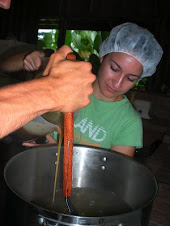Biodynamics and the concept of farming according to the lunar cycle is very cool. Not only can it be applied to agriculture, but also to daily life! Gustavo, our agriculture intern from EARTH University, has a book written by Johanna Paungger and Thomas Poppe that describes how the lunar cycle can be incorporated in daily life. For example, one section of the book describes days that are best for haircuts, and days when the moon is in Leo or Virgo are best. The two times differ a bit in that Virgo is best for a long lasting haircut, while Leo is better for overall hair strength. I’m not sure how this was measured, or the validity of the claims, but I’m eager to give it a try, especially since I’m in a bit of a need for a haircut. The book has been translated in several languages and the English version is titled Moon Time: The Art of Harmony with Nature and Lunar Cycles.
I’ve been learning so much about Biodynamics since I’ve been here. I’ve also been doing a lot of reading about soil preparation and composting. I had no idea what a science composing is. Farming biodynamically and organically is not only good for our health, but for the health of the planet. The concept of planting with lunar and planetary phases is especially interesting, in part because it connects our food to something greater than just the earth; it connects it to the universe. The ways in which lunar cycles are used in agriculture are based on simple concepts, for example, a full moon will draw up sap from a tree and is therefore a good time to harvest sap, but it is an especially bad time to harvest trees for wood since there will be a high moisture content in the wood, causing it to rot easily. Days around a new moon are ideal for wood harvesting since there will be a low water content in the wood. I’ve also learned that mornings are best for picking fruit and leafy greens since the water content in the leaves and fruit are greatest in the mornings before the sun gets too hot. Evenings, on the contrary, are best for harvesting root plants, like carrots and potatoes, because the plant’s energy is concentrated in the root. Unfortunately these methods are costly to employ on a commercial level since it is inefficient to use labor at a different time each day.
People, like plants, also have certain unshakable biorhythms. Birds rely on their biorhythms to coordinate roosting and food gathering with their partner. Another example is how, inexplicably, certain chemotherapies have higher success rates in cancer patients depending upon the time they are administered. Despite research and promising results, the practice of cancer therapies according to biorhythms is not performed, sadly because it is too difficult to coordinate staffing of such health professionals round the clock. Another example is that people function most efficiently during daylight hours, regardless of change in sleeping habits. Those who work the night shift are often prone to make mistakes and some of the greatest disasters our world has seen have occurred in the hours between 1 am and 5 am, during the night shift. The Chernobyl nuclear explosion, which occurred at 1:23 am, is one such example.
People, plants, and animals all have biorhythms, and such biorhythms are accumulations of behaviors and hormones changes which are regulated by the sun and moon. I’ve learned how these biorhythms involve the sun and how they affect humans and animals, but I’m also now beginning to learn the importance of lunar cycles and how plants are equally affected. Fascinating.
Friday, December 12, 2008
Subscribe to:
Posts (Atom)






